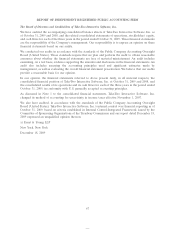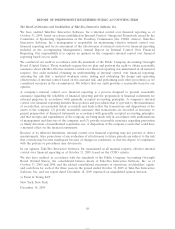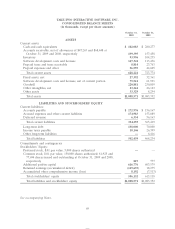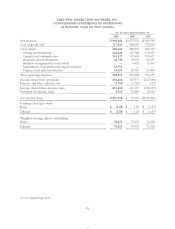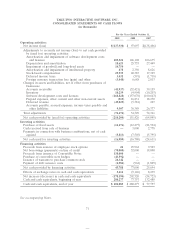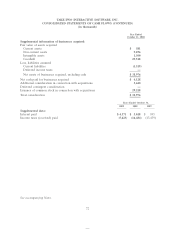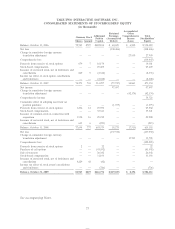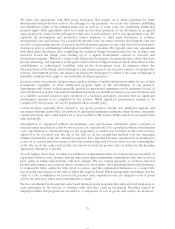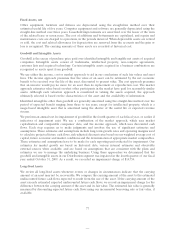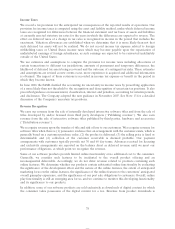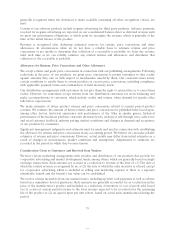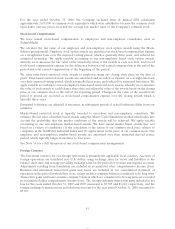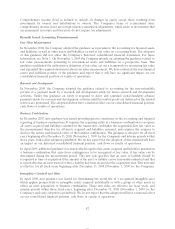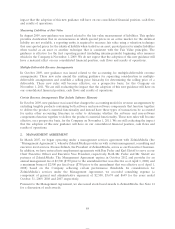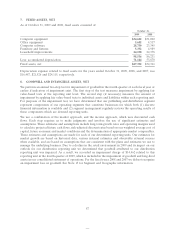2K Sports 2009 Annual Report Download - page 82
Download and view the complete annual report
Please find page 82 of the 2009 2K Sports annual report below. You can navigate through the pages in the report by either clicking on the pages listed below, or by using the keyword search tool below to find specific information within the annual report.Fixed Assets, net
Office equipment, furniture and fixtures are depreciated using the straight-line method over their
estimated useful life of five years. Computer equipment and software are generally depreciated using the
straight-line method over three years. Leasehold improvements are amortized over the lesser of the term
of the related lease or seven years. The cost of additions and betterments are capitalized, and repairs and
maintenance costs are charged to operations, in the periods incurred. When depreciable assets are retired
or sold, the cost and related allowances for depreciation are removed from the accounts and the gain or
loss is recognized. The carrying amounts of these assets are recorded at historical cost.
Goodwill and Intangible Assets
Goodwill is the excess of purchase price paid over identified intangible and tangible net assets of acquired
companies. Intangible assets consist of trademarks, intellectual property, non-compete agreements,
customer lists and acquired technology. Certain intangible assets acquired in a business combination are
recognized as assets apart from goodwill.
We use either the income, cost or market approach to aid in our conclusions of such fair values and asset
lives. The income approach presumes that the value of an asset can be estimated by the net economic
benefit to be received over the life of the asset, discounted to present value. The cost approach presumes
that an investor would pay no more for an asset than its replacement or reproduction cost. The market
approach estimates value based on what other participants in the market have paid for reasonably similar
assets. Although each valuation approach is considered in valuing the assets acquired, the approach
ultimately selected is based on the characteristics of the asset and the availability of information.
Identified intangibles other than goodwill are generally amortized using the straight-line method over the
period of expected benefit ranging from three to ten years, except for intellectual property, which is a
usage-based intangible asset that is amortized using the shorter of the useful life or expected revenue
stream.
We perform an annual test for impairment of goodwill in the fourth quarter of each fiscal year, or earlier if
indicators of impairment exist. We use a combination of the market approach, which uses market
capitalization and comparable companies’ data, and the income approach, which uses discounted cash
flows. Each step requires us to make judgments and involves the use of significant estimates and
assumptions. These estimates and assumptions include long-term growth rates and operating margins used
to calculate projected future cash flows, risk-adjusted discount rates based on our weighted average cost of
capital, future economic and market conditions and the determination of appropriate market comparables.
These estimates and assumptions have to be made for each reporting unit evaluated for impairment. Our
estimates for market growth are based on historical data, various internal estimates and observable
external sources when available, and are based on assumptions that are consistent with the plans and
estimates we use to manage the underlying business. Using these approaches we determined that the
goodwill and intangible assets in our Distribution segment was impaired in the fourth quarter of our fiscal
year ended October 31, 2009. As a result, we recorded an impairment charge of $14,754.
Long-lived Assets
We review all long-lived assets whenever events or changes in circumstances indicate that the carrying
amount of an asset may not be recoverable. We compare the carrying amount of the asset to the estimated
undiscounted future cash flows expected to result from the use of the asset. If the carrying amount of the
asset exceeds estimated expected undiscounted future cash flows, we record an impairment charge for the
difference between the carrying amount of the asset and its fair value. The estimated fair value is generally
measured by discounting expected future cash flows using our incremental borrowing rate or fair value, if
available.
77


